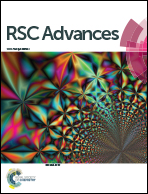Switch on fluorescence mode for determination of l-cysteine with carbon quantum dots and Au nanoparticles as a probe†
Abstract
Citric acid and urea were used as precursors for the preparation of carbon quantum dots (CQDs) which exhibited a maximum emission wavelength at 515 nm when excited at 410 nm. Upon addition of citrate-stabilized Au nanoparticles (AuNPs) with the maximum absorption wavelength at 520 nm, the fluorescence of the CQDs could be efficiently quenched, attributed to the energy transfer between CQDs and AuNPs. However, the further introduction of L-cysteine (Cys) could cause the aggregation of AuNPs along with a drop in absorption at 520 nm, resulting in the fluorescence recovery of the CQDs–AuNPs system. Therefore, a simple and reliable switch on fluorescence sensing platform for determination of Cys was constructed. The significant factors, such as pH and incubation time, that affected the detection of Cys were optimized with the AuNP concentration set as 2.50 nM at room temperature. Under the optimized conditions, the fluorescence recoveries (ΔF) were strongly correlated with Cys concentration in the 0.20 to 4.0 μM range, and the detection limit is 0.012 μM. More importantly, our CQD-based sensing platform was successfully used for the detection of Cys in milk samples with high precision and accuracy, indicating the potential of the probe in practical applications.



 Please wait while we load your content...
Please wait while we load your content...